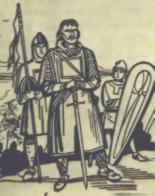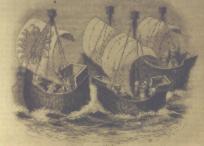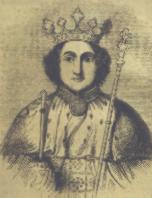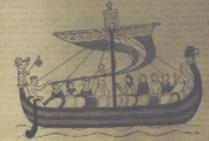
The Unwritten History Of Australia
|
The Southern Paradise
of Sir Owain Miles
|
"With the Quest of Sangrail all you of
the Round table shall depart, and never
shall I see you wholly together again".
King Arthur to his knights
Le Morte d' Arthur
by Sir Thomas Mallory, 1485
|
Chapter
21 Images
|

|
Sir Owain Miles
In the manner of a knight of the Round Table on an endless quest for for the Holy Grail, that highest aspiration of Mediaeval man, he haunts the pages of late Middle Ages romantic literature, amid that grey misty land where myth and legend fiction and fact are one.
Sir Owain Miles, or rather the image of the man which has come down to us is all of these, and it is the task of this author to seperate as much as is possible, the man from the myth and romanticised folklore surrounding him, to reveal, I believe, an actual historic figure, and a brave Welsh explorer who, despite the mythological romanticism shrouding his achievement, explored Australia over 600 years before the arrival of Captain James Cook.
What is known of Sir Owain Miles, comes from three people: Henry of Saltry, a Cistercian monk and historian of the Benedictine Abbey in Huttingdonshire; Gilbert, Abbot of Louth, Lincolnshire; and Princess Marie of France. All lived during the reign of King Henry the 2nd of England {reigned 1154-1189}. Marie was a half-sister of the king, and spent sometime in the circle of his English and Norman courts, and was made by him Abbess of a nunnery at Shaftesbury.
She possessed a distinguished literary talent which she combined with a disinclination to be married! Marie wrote lais, verse renderings of knightly stories already known, and which were current among the Breton conteurs from whom she heard them. The story goes that Gilbert the Abbot, a Cistercian, related details of a fabulous vision of the Purgatorial Underworld of the Blessed St Patrick, given by his interpreter, a Welsh knight, Sir Owain Miles, to a fellow Cistercian monk, Henry of Saltry, Huntingdonshire.
He wrote down the account between 1180-1184, which eventually came to the attention of Princess Marie of France, who subsequently translated it into French metre. Gilbert is also said to have written his own version of the tale.
According to these accounts, the Purgatory of St Patrick {5th century BC} could be reached through a cave whose entrance, sealed by a door, lay behind the altar of a great abbey in the town of Vernic, on Station Island, in Lough Derg, County Denegal, Ireland. Into this a number of travellers had, it was said, gone to experience the terrors of Purgatory, the door being locked behind them.
|
Pyramids
in the Pacific Ch 21 Images
|

|

|

|
|
Ocean Going Ships |
King Richard the 2nd |
William the Conqueror |
They were usually informed by priests beforehand that St Patrick himself had said that, anyone who spent time in his Purgatory would be excused from returning to Purgatory after death and go straight to heaven...The cave was said to have been discovered by St Patrick while a hermit, and had been a place for expiation of one's sins ever since.
It was for this reason that Sir Owain Miles visited the abbey in about 1154. The facts surrounding this knight are hazy. It is however known that Owain {also pronounced Owen} served King Stephen of Blois, who reigned over England from 1135 to 1154. It was the time of the Norman rulers.
While the reign of Henry the 1st had been comparatively peaceful, with strong government and much prosperity, his death in 1135 ushered in a period of unrest. King Henry has been described in contemporary accounts as an energetic, brilliant man and well educated.
He was a short, burly, red-headed man who attracted and enjoyed the company of scholars and promoted an economic boom in the 35 years of his reign. He encouraged merchants to travel overland to obtain the riches of the east. With his death the royal succession came into dispute. Henry was survived by a daughter, Matilda, the wife of Geoffrey Plantagenet, count of Anjou.
The marriage had been arranged by Henry, in an effort to heal the bitter rivalry that existed for some time between the two powerful northern French kingdoms of Normandy and Anjou, and England. However, not long before his death, his daughter bore him a grandson, Henry Plantagenet, who was destined eventually to rule over a vast territory that included Anjou, Normandy and England.

|

|

|
|
King Henry the 2nd |
King Edwards the 3rd |
King Stephen Blois |